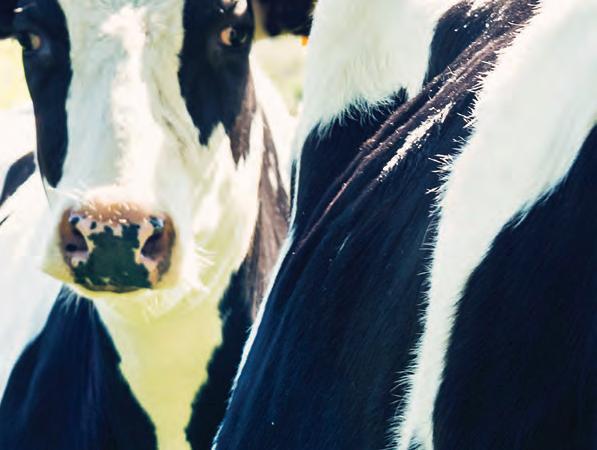






Multispecies pasture is a hot topic right now, with multiple on-farm trials under way across our dairying regions . PAGE 10

Imagine a day on your farm where the alleys are always clean, giving you more time to focus on what truly matters.
With their long-lasting stainless-steel base and consistent, high-volume flush, GEA Flush Valves make this possible. Their automated, low-maintenance, and easy-to-install design ensures hassle-free operation. Contact










Enhances the nutrition of whole milk and pasteurised surplus milk programs
High fat for optimal animal growth
High protein to encourage solid food intake and mammary development
Custom Probiotics for gut health and development
Celmanax for immune support and performance










PROVICO ENHANCE is a premium milk powder with a high protein-to-fat ratio, enhancing the protein content of whole milk and extending the availability of waste milk, reducing saleable milk usage.
PROVICO ENHANCE ensures consistency when using milk from mixed sources, such as fresh cow milk and other surplus milk.









admin@provicorural.com.au www.provicorural.com.au




A DAIRY plan for Queensland is another step closer.
The advisory group which is guiding development of Queensland’s dairy plan has started looking at all of the feedback received so far and identifying priorities and common themes — issues which must be addressed in the plan, and ideas for change.
EastAUSmilk is leading development of the plan, with government relations manager Mike Smith saying the plan is all about growing Queensland’s milk pool, building the economic viability of the industry, facilitating productivity and efficiency improvements, and building confidence in the future of the industry in Queensland.
“Queensland needs an effective dairy industry plan to make sure Queenslanders can drink fresh local milk into the future, that farmers run profitable businesses, and their communities remain vibrant,” Mr Smith said.
“Right now that’s not where we are. We have the smallest average dairy herd size of all states, our farms produce just 45 per cent of the milk Queenslanders consume, we’ve got only 40 per cent of the farms we had in 2011, and too many farmers are struggling to make a decent income.”
Mr Smith said feedback had been received

from six district meetings (about 120 people attended all together), discussions among advisory group members themselves, and individual discussions with SubTropical Dairy, larger processors, and others.
“In addition, eastAUSmilk has received emails from several individuals about the problems they see as priorities, and suggesting solutions, and received responses to our invitation for online submissions.
“Notes of district meetings and other discussions, together with online and email input, have amounted to many thousands of words and over a hundred pages of notes.”
The advisory group is made up of
representatives from eastAUSmilk, SubTropical Dairy, Department of Agriculture and Fisheries, Lactalis, Bega, Norco and Dairy Farmers Milk Co-operative.
They all want to bring the industry together to lift production, increase farm gate profitability and drive efficiencies throughout the supply chain.
Mr Smith said once the advisory group has digested all the feedback and proposals received so far, the next steps will include seeking advisory group consensus on the issues which must be addressed and proposals for change, then trying to reduce them to a smaller number of concrete proposals which will have a real and lasting impact.
The group will then have to weave them into a draft plan.
“Once draft documents are ready to put in front of farmers, processors and other stakeholders, we’ll schedule another round of faceto-face consultations including district meetings,” Mr Smith said.
“Once that further feedback has been received, the advisory group is expected to modify their draft, and propose a final plan.”
For more information about the Queensland Dairy Plan, go to the eastAUSmilk website.
EastAUSmilk has been successful in securing funding through the Department of Agriculture and Fisheries to improve technology uptake on Queensland dairy farms.
The first round of grants for the Dairy Farmers Technology Uptake Program (DFTUP) has closed, offering 25 per cent of total tech cost up to a maximum of $15,000 (ex GST) per dairy business.
There are two parts to the program — multiple information and training workshops in each dairying region, and provision of financial assistance for technology uptake.
The program aims to increase knowledge and adoption of technology to improve labour efficiencies as well as cow health, welfare and fertility.
The dates for workshops and training sessions will be announced soon.
However, if there is a particular technology you are interested in and want to learn more about, please get in touch.
Grants available to eligible dairy farmers in Queensland include eligible items such as:
Autodrafting gates.
Automated feeding systems.
Cup removers.
Auto calf feeders.
Drones (spray or fertiliser).
Heat detection collars or ear tags.
Precision technology.
Mobile app upgrades and towers.
Somatic cell count sensors/in-line SSC detectors.
EastAUSmilk project officer Jade Chan said businesses in general were struggling


with labour shortages, with businesses in rural or regional areas facing bigger challenges due to lack of population density and accessibility.
“Mechanisation or technology investments on-farm looks to not only improve labour efficiencies resulting in less time demanded per job but also improve decision making and enhance business planning,” she said.
“The addition of technology on farm can provide additional benefits which includes improved herd health management and monitoring.
“Automated calf feeders, for example, reduce labour and improves overall welfare for the calf, with the option to tailor feeding rates per calf but also maintaining optimal hygiene of the equipment.”











The Australian Dairy Products Federation says this year’s lower farm gate milk price has been set to preserve the viability of the dairy industry.
The federation, representing dairy processors, pointed to the flood of imported dairy products that followed several years of record high milk prices.
Federation chief executive officer Janine Waller said during the 2022 and 2023 year, imports surged by 17 per cent, leading to the highest-ever consumption of overseas dairy products in Australia, nearing 30 per
cent or 344,000 tonnes.
“We want to ensure Aussie families can continue to enjoy affordable, locally made and branded milk, cheese, yoghurt, butter and ice-cream in their homes,”
Ms Waller said.
On July 1, the estimated weighted average farm gate milk price in the southern region ranged from $7.94 to $8.20/kg milk solids.
“Following two years of record high farm gate milk prices, this remains up to 14 per cent higher than it was three years ago
(financial year 2021-22),” Ms Waller said.
“Compared to the farm gate milk price paid by major global competitors, the southern Australian price remains at a premium.
“It is up to 10 per cent higher than New Zealand’s milk price midpoint of A$7.43/kg milk solids.
“It’s important to remember the announced farm gate milk prices are minimums for the season, with incentives on offer and the possibility of price reviews as global market conditions improve.
“We encourage farmers to use the dairy industry’s milk value portal which provides transparent and comprehensive data on farm gate milk pricing, offering insights into current and historical rices and market trends.”
Latest figures released by Dairy Australia show cheese exports are rising, in value and tonnages.
However, two of the bigger categories — skim milk and whole milk powders — are lower than the same time last year.
About 30 per cent of Australian milk production goes into exports.
BY SOPHIE BALDWIN
IT MIGHT be the start of a new financial year, but for many dairy farmers it will be the start of a tough season with milk prices dropping below the cost of production.
For northern Victorian dairy farmer Pat Nicholson, an ACM supplier, the drop means a $300,000 reduction in income with the price paid per litre falling from 81¢ to around 70¢.
“We will have to cut back to essential spending only and just do whatever we can to survive in the short term,” Mr Nicholson said.
“We have already made the decision we will not stay on in the industry just to lose money — we will sell up rather than go through that type of financial pressure ever again.”
He said in the short term, the business will look into cutting back stock numbers to reduce feed costs and then reassess the future as the months progress.
It wasn’t all that many years ago the Nicholson family from Girgarre, due to tough industry conditions, sold a large portion of their well-known Jugiong Jersey herd and were on the point of leaving the industry all together.
“Previous generations battled on through tough times and worked for nothing but the current generation won’t put up with that ever again,” Mr Nicholson said.
“Why as dairy farmers should we have to work so hard every day of the year just to lose money or break even if we are lucky, just to prop up the profitability of processors?”
In Mr Nicholson’s opinion, processors have underestimated the impact this decision will have on domestic production moving forward.
“I have already spoken to one person who said after speaking to his financial adviser he was going to offload one of his blocks and a full-time employee — that’s the flow-on effect of these decisions.”
While Mr Nicholson acknowledged the industry is coming off the back of a couple of really good years, the catch up has only come after way too many poor years which tested resilience and saw the Australian dairy industry shrink to its lowest ebb in decades.
“There is still no room in anyone’s budget for a financial loss.
“Over the last two years the milk price just kept jumping up and I understand $10/kg MS might not have been sustainable for processors but $8 isn’t sustainable for us either and we need to find a happy medium or we won’t have an industry at all.”
Mr Nicholson said over the past couple of years his dairy business had invested in some much-needed capital projects, including lasering and collars for the cows.
“A price drop now means we don’t spend and then the businesses in our local community start to suffer — it’s a flow-on effect when we don’t replace the tired old tractor or the ute that won’t start on a frosty morning.
“We add a bit more hay band to fence repairs and we certainly won’t go to the local pub or restaurant for dinner as often as we would previously.
“It is a well documented fact when dairy farmers take a financial knock the whole community is impacted.”
Mr Nicholson said he fears for a whole generation of dairy farmers who are again questioning their future in industry.
“You cannot underestimate the impact this

price drop will have on the mental health of our region’s farmers.
“We all thought prices below the cost of
very poor message and will not encourage
one to invest in this industry.”
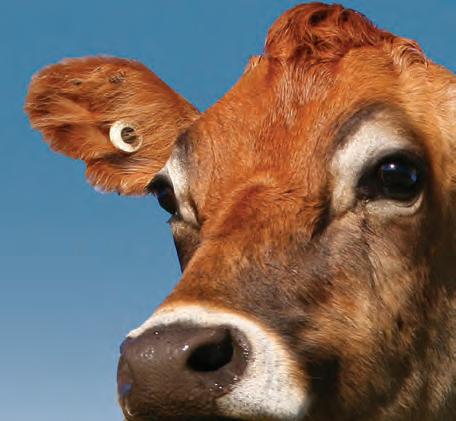




BY GEOFF ADAMS
SOUTH AUSTRALIAN dairy exports have enjoyed a growth phase over the past 12 months, according to figures released by the state government.
Dairy exports have grown by 23 per cent year-on-year, and are now valued at more than $150 million per year.
The most recent trade data released by the Australian Bureau of Statistics shows South Australia exported 31.3 million kilograms of dairy products in the year-to-date, with all subcategories recording growth in volume and value.
The cheese sector has enjoyed the largest growth, up by 40 per cent to $71 million, followed by the ‘other’ dairy category with 39 per cent.
By country, $20.8 million worth of cheese was sold to the Philippines (up 18.4 per cent), $15.9 million to China (up 93.2 per cent) and $13.3 million to Thailand (up 6.8 per cent).
In the milk category, $23.4 million was exported to Thailand (up 160.5 per cent), $22.7 million to Indonesia, and $8.8 million to China.
More than 500 South Australian businesses have been supported over the past 12 months to grow their exports by TradeStart, a program co-funded by the federal and South Australian governments.
The Yoghurt Shop in Adelaide is one of many dairy companies that has seen significant export growth since engaging with TradeStart, entering three new countries in the past six months.
From humble beginnings running a single stall in the Adelaide Central Market, The Yoghurt Shop has grown significantly, now exporting to nine countries across more than 5000 retailers.
South Australia Trade and Investment Minister Joe Szakacs said South Australia was known globally for its premium produce, and the government was ready to support any local producer looking to expand into overseas markets.
Woodside Cheese Wrights is a South Australian company exporting cheese products to the United States.
Chief executive officer Kris Lloyd said the company was using native Australian ingredients supported by the excellence of local biosecurity, identifying the source at every level.
“Our recent contracts with Wholefoods Markets and Costco in the US are a testament to the appeal of our products in these highly contested markets,” Kris said.
“We look forward to continuing our work with TradeStart to enable our continued growth and successful export journey.”
The dairy industry now has access to a new training program designed to build exporter skills and knowledge.
The course — Culture: Growing Dairy Exports — was developed in partnership with Dairy Australia and Charles Sturt University.
Deputy Secretary for Trade Tina Hutchison said this free program would support Australia’s dairy export sector.
“The five-module training course will upskill industry and develop their knowledge of export regulatory requirements,” Ms Hutchison said.
“The training focuses on whole-of-system thinking that improves participants’ ability to establish internal monitoring and verification systems to meet the export dairy regulatory requirements.
“Users will be able to engage with 3D animated scenarios showing them the impacts of non-compliance, and the effectiveness of root-cause analysis and communications.
“Toolkits have been designed to assist in implementing skills gained in training into the work of various roles within a dairy establishment.
“These toolkits provide guidance and practical tools to help build and maintain company culture and quality assurance processes, and emphasise the value of a proactive systems-based approach for managing export regulatory requirements.”
For more information and to access the training course, visit: https://www.agriculture.gov.au/ biosecurity-trade/export/controlledgoods/dairy/welcome-pack/ dairy-training-tools#da -page-main
Peloris Global Sourcing Pty Ltd has celebrated a significant milestone, marking 10 years of uninterrupted delivery of fresh milk to China.
Over the past decade, Peloris has delivered more than eight million litres of Australian fresh milk to meet the growing demand of Chinese consumers, with uninterrupted weekly shipments and zero cold chain non-compliances for what is classified in China as a high-risk food category
In 2013, Peloris was approached by representatives of the NSW dairy industry to develop a commercially viable China market access solution for Australian fresh milk products — the key challenges being cold chain temperature control and import clearance lead times.
After working collaboratively with the General Administration of Customs China (GACC) over a period of 18 months to develop suitable cold chain transparency and import traceability protocols, Peloris conducted initial trial shipments in July 2014 with commercial shipments commencing the following month.
Demand for Australia fresh milk in China has subsequently increased year on year with annualised 2024 sales expected to exceed 1.6 million litres.
Peloris managing director Peter Verry said Chinese consumers were continuing
to choose imported food brands which provide the traceability and transparency to reassure themselves of product provenance, quality and safety.
“The bespoke systems we have put into place — including export preparation, clearance protocols and the ability to track the location and temperature of every delivery — ensures full accountability,” he said.
“We have worked closely with the Chinese authorities over the past 10 years to ensure our food exports are fully compliant China food health and safety regulations. This is reflected in our 100 per cent import compliance record over the more than 500 shipments over the past 10 years.”
More recently, Peloris partnered with GACC Shanghai to develop China’s first fresh milk Fastlane clearance pilot (launched in February 2020) and is currently one of only three importers accredited by GACC Shanghai for the fresh milk Fastlane program, which has reduced import clearance times to under 24 hours.
Mr Verry said Peloris had also worked closely with Federal Government and industry bodies to share their learnings and assist other Australian food exporters, particularly with understanding and navigating China’s complex food import regulations.














BY ANDY WILSON
THE 10TH Victorian Winter Fair dairy show wrapped up its 2024 competition with 185 entries in front of almost 1500 visitors across the three-day event.
A first-class line-up of Holsteins brought together the cream of Victoria’s dairy breeders and producers to the Bendigo Exhibition Centre from July 2 to 4.
Organiser Claire Modra said the show was a great success with more people on the heifer
day than in previous years.
“The quality of the entries was very good,” Mrs Modra said.
“The feedback from the judge (Lachlan Fry) was that there was very much depth within every class.
“He said overall it was very consistent, and you could see that when he had the champion line-up, they were all similar sorts of cows.”
Tuesday, July 2 saw junior handlers compete with their showmanship skills across six categories.
Nate Chesworth excelled in the ring to win first place in the Under-12 ProDairy Junior Showmanship.
Stacey Gleeson won the same category in the 12-15 years class, and Abbie Hanks won the 16-21 years class.
In the Junior Judging class, Isla Robertson won first place for handlers under-12, Violet Dodd won 12-15 years and Luke Gardiner won for handlers aged 16-21.
The honour of Supreme Senior Champion went to Rockwood Park Atley Cretonne, exhibited by View Fort Holsteins and Jerseys.
A newcomer has taken this year’s Highest BPI Heifer Award at the Victorian Winter Fair.
Newhope Dylan Butter, owned and bred by Bruce Fuller at Shepparton, topped the heifer entries with a Balanced Performance Index of 352.
The BPI Awards were presented by DataGene in collaboration with Holstein Australia and the Winter Fair Committee.
DataGene is an initiative of Dairy Australia and the herd improvement industry, and the Balanced Performance Index (BPI) is a measure of an Australian dairy animal’s genetic merit for the combination traits that contribute to a profitable business including production, health and fertility, overall type and feed efficiency.
At just 11 months old, Dylan Butter’s genomic results provide detailed insight into her future performance.
Of all the heifers entered in the Winter Fair, Dylan Butter had the top BPI calculated by DataGene in the June 2024 genetic evaluations. At BPI 352, she ranks among Australia’s top Holstein females.
The Highest BPI Cow Award went to Emu Banks Lastin Jackie, owned and bred by Bryan and Jo Dickson of western Victoria.
Lastin Jackie ranks highly on all three of DataGene’s genetic indices with a BPI
Dairy News Australia is published by Shepparton Newspapers Pty Ltd. All editorial copy and photographs are subject to copyright and may not be reproduced without prior written permission of the publisher. Opinions or comments expressed within this publication are not necessarily those of the staff, management or directors of Shepparton Newspapers Pty Ltd.
of 405, Health Weighted Index of 410 and Sustainability Index of 711 and recently classified VG 86 on her first lactation.
Peter Williams from DataGene congratulated both breeders for their outstanding breeding achievements.
“Most dairy farmers want to breed cows that will have long, productive lives in their herd,” Mr Williams said.
“To do this they need a combination of traits for profitable production and strong conformation and the genes to produce the next generation of great cows.
“Looking at the breakdown of Dylan Butter’s BPI, she is a good all-rounder, with high Australian Breeding Values for all the traits that contribute to the BPI.
“She has exceptional type traits with an Overall Type ABV of 110 and Mammary System ABV of 114 as well as above average ABVs for production and health traits, especially protein, fat, mastitis resistance and daughter fertility.
“We congratulate Bruce on his success in breeding outstanding cows and presenting Dylan Butter at the Winter Fair.”
Not only does Dylan Butter have a high BPI, she also performed well in the show ring, placing sixth out of 15 in her class. ɋ For more results, visit: https://www. facebook.com/victorianwinterfair/
Advertising Max Hyde 0408 558 938 max.hyde@dairynewsaustralia.com.au
Editor Sandy Lloyd (03) 5820 3252 editor@dairynewsaustralia.com.au
Regional editor news@dairynewsaustralia.com.au
Reserve Champion was won by Carisma Samite Piper, from M. and J. Deenen.
Supreme Junior Champion was won by Gorbro Sidekick Ruth by Gorbro Holsteins.
Supreme Udder of the senior show was won by Winwood Tatoo Lights Out, exhibited by Mal Nikora and Kelly Bleijendaal.
Mrs Modra has seen the show go from strength to strength since its inception in 2014 and thinks the formula for running the event does not need tweaking for next year.
“Why change it?”
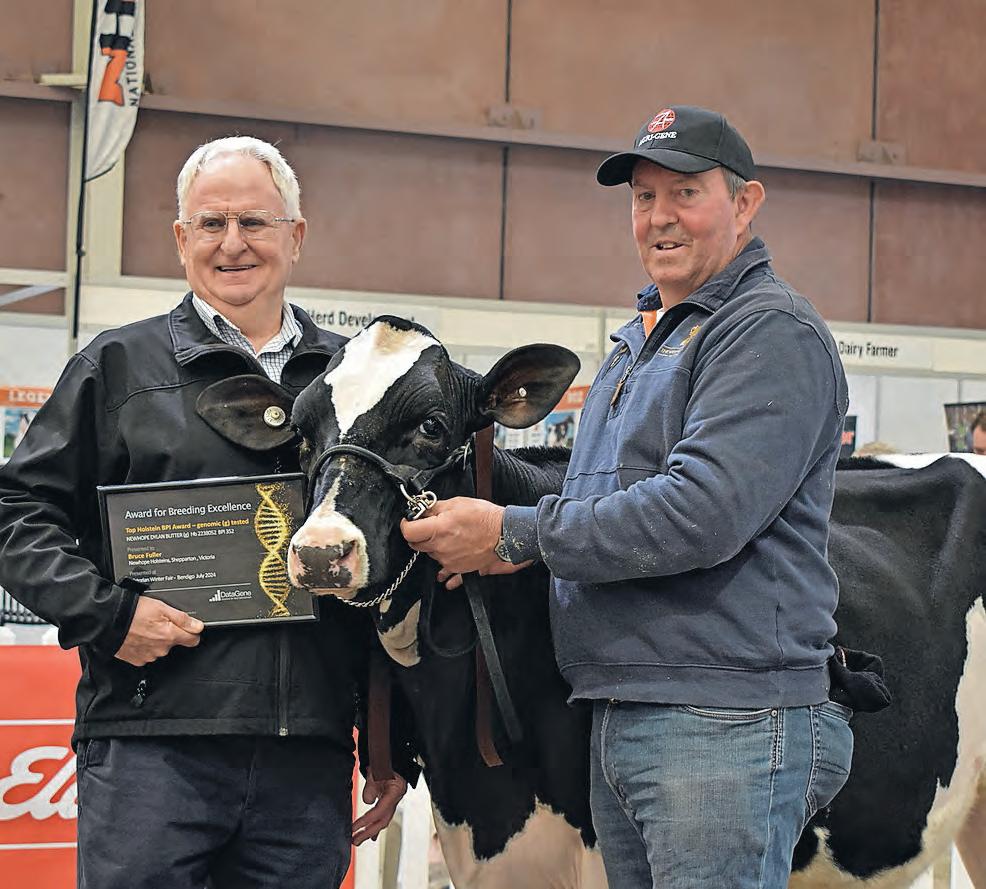
Publisher Shepparton Newspapers Pty Ltd
Printed by Newsprinters Pty Ltd
Head Office 7940 Goulburn Valley Highway
Shepparton, VIC 3630
Phone (03) 5831 2312
Postal address PO Box 204
Shepparton, Victoria 3632 Australia
Dairy News Australia welcomes contributions from stakeholders in the dairy industry, and particularly from organisations wishing to advance the industry.
Contributions and photos can be sent to: editor@dairynewsaustralia.com.au
Letters to the editor on topical issues are also welcome.
Letters should be concise and carry the name and town address of the author, as well as a contact phone number, not for publication.

























































































































$4,000
Thursday 5th September at 1pm


With the dairy industry as diverse as it is, and our dairy people being the backbone of the industry, it is no wonder there are so many personal stories out in our dairy community. Our panel members have heartwrenching and challenging stories to tell, which have shaped them into the resilient people they are today.
Join Colin Gray and Ancret Shipton and listen to what challenges have been thrown at them, and how they have adapted to their new life.
Along with Chloe Brown, podcaster and dairy farmer come along and join us to hear about the stories and challenges she holds from the people that confide in her.

Panel members: Colin Gray Dairy farmer Nilma, Ancret Shipton Dairy farmer Bega and former Nar Nar Goon Focus Farmer, Chloe Brown, Westen Victorian Dairy farmer and podcaster.






















• Australian Family owned business
• Trusted Performance since 1984



• Your farm deserves Australia’s leading dairy automation systems proudly backed by the team who designs and builds it
• Over 20 Years of great products and exceptional service

• Greenmate Ag are soil regeneration specialists. Let us help you drive production and quality through high end testing methods and industry leading products



• Founded by farmers for farmers
• Proud supporters of Gippsland’s thriving dairy industry

• Australian wide suppliers of Dairy Effluent equipment
• Well known brands including; Yardmaster, Bauer, Williams & Yardblaster





• The most versatile sprayer in the world
• Apply all your fertiliser in one pass


• Your one-stop-shop for grain and pellet silos, stock-feeders, augers and bins in Gippsland and beyond - design, manufacturing, repair, and transportation services included
• Benic calf trailer agent and manufacturer



• A leading dairy processor in Australia
• High quality dairy products for domestic & international markets

• Gippsland’s specialists in automatic milking systems with over 20 years of experience here in Australia
• Helping support over 80 Lely robots on Gippy farms









• For over 30 years Burra Foods has represented quality and innovation in the dairy market
• Committed to investing in Gippsland’s future



• Supporting profitable and sustainable dairy farming
• Visit our website www.gippsdairy.com.au

• Automatic milking and feeding systems, digital herd management, manure handling equipment and farming components


• ProDairy; we’ve got you covered
• Designed for Dairy Farmers, Delivered by Dairy Vets






• Fuels, Lubricants & Ad Blue
• Farm, industrial & retail
• Locally owned and operated
• www.evanspetroleum.com.au




• Your local John Deere equipment specialists
• Elevating your operation with unwavering support, superior machines, unparalleled service and a dedicated team












S O UTH





















• nbn Local’s purpose is to lift digital capability at a local level, facilitate positive customer experience outcomes and create shared economic and social benefits for rural and regional Australians




































Wednesday 4th & Thursday 5th September 2024 • 10am - 3pm



























BY JEANETTE SEVERS
A LACK of scientific rigour around the planting and grazing of multispecies pastures has prompted a multi-site on-farm project led by Dairy Australia and the University of Melbourne.
There are two trial sites, at Goon Nure in East Gippsland and Tallandoon in the Mitta Mitta district.
Both are being used to research the effectiveness and resilience of multispecies pastures. The project is funded from the Federal Government’s Future Drought Fund Resilient Soils and Landscapes program and Dairy Australia.
An original research project funded only by Dairy Australia was hosted on 11 farm sites, spread across Gippsland, south-west Victoria and northern Victoria.
That work has now been distilled to continue on two and a potential third site.
Rohan Bingley, whose dairy farm at Goon Nure is the host site for the trial in Gippsland,
was already growing multispecies pastures for his 90-head milking herd.
An on-farm open day was held on June 26 at Goon Nure to report on the project to-date.
It was attended by dairy farmers, extension service personnel and research scientists involved with the project from the University of Melbourne’s School of Agriculture, Food and Ecosystem Sciences.
The Goon Nure trial is measuring annual and seasonal pasture production and quality comparing rye-grass and multispecies pastures, changes in the composition of multispecies varieties, and soil health including carbon levels, microbe population and water holding capacity.
A few moisture probes have been installed on the Goon Nure property as part of this research project.
“People are adopting multispecies pastures, but there isn’t a lot of scientific evidence around their effectiveness,” University of Melbourne Associate Professor Brendan Cullen said.
“From a dairy system perspective, where
does multispecies fit in to the dairy production system?
“Would multispecies pastures enable reduced use of synthetic nitrogen?
“Can we push increased growth out on the shoulders of the growing seasons?
“Do multispecies pastures protect soils from erosion?
“Is there potential to measure animal performance, in the next step of our research?
“We’ll measure the performance of the pasture as a whole, and the proportions of species.”
Other UniMelb research indicates the use of nitrogen fertilisers is projected to increase by 70-100 per cent by 2050.
But an estimated 50 per cent of nitrogen fertilisers applied to agricultural systems is lost into the environment through leaching and emissions.
This is a burdensome cost to farmers with substantial environmental impact.
Reducing this wastage and cost is important in the dairy industry.
The multispecies varieties sown at Goon


Nure were a mix of grasses, legumes and herbs.
For a number of years now, Rohan has utilised pelletised chicken manure and a Tow and Fert to spread fertiliser around his farm. This year, he applied 300kg/ha of pelletised chicken manure.
“Slow release nitrogen applied in early spring gives us a kick in pasture growth,” Rohan said.
Soil is sandy loam with a pH of 7.15. The trial sites are rainfall-dependent. Centre pivot irrigation is used on other paddocks. The farm is coastal, with strong impact from daily sea breezes.
Rain in December ensures peak growth. The herd is dried off in late December, which enables paddocks to be rested.
Calving occurs in late January and February, and Rohan relies on autumn growth for freshly calved cows.
He also relies on spring pasture for grazing heifers.
The trial was sown in paired paddocks, a mix of rye-grass and clovers in one paddock alongside a paddock of multispecies varieties.
Moisture probes were set up in each paddock.
Pasture cuts were taken pre-grazing, resulting in 0-3 tonne dry matter per hectare.
Daily pasture growth rate was measured at 0-50kgDM/ha per day.
“In summer, multispecies absorb more moisture from the deeper layers of the soil, compared to rye-grass, which is in the top few centimetres,” Rohan said.
“In winter, the rye-grass performed better than the multispecies.
“In spring, the multispecies varieties out-performed the rye-grass mix.”
Brendan said the trial so far had demonstrated the multispecies varieties performed well in the shoulder of the season, and there was a small growth advantage in the summer.
“We’re also seeing the pasture species composition changing season to season at Goon Nure,” he said.
In comparison, he said regular topping needed to occur at the trial at Tallandoon to encourage cows to keep grazing.
Brendan said there were seasonal differences at Goon Nure, that varies the economic and production value of growing additional dry matter throughout the year.
“When rye-grass outperforms multispecies during winter, the multispecies has lower value,” he said.
“A rye-grass flush quantifies to about a $110/ ha loss on the value of multispecies pasture.
“The multispecies pasture has higher value at other times of the year, especially in







mid-summer, but also mid-spring, late summer and during autumn. This quantifies to about $270/ha.”
In contrast, Brendan said at the Tallandoon site in north-east Victoria, rye-grass produced more forage by volume than the multispecies pasture.
“For economic analysis, we need to know the pattern of growth and volume during the year, and compare these results with the whole system,” he said.
“Over the next year, we should be able to gather enough data across all the sites to help qualify our results.”
Rohan said the multispecies had no value as silage, in comparison to rye-grass.
“If you have a part of your milking platform under pivot that you harvest for silage, don’t plant it to multispecies,” he said.
He recommended knowing input costs and comparing those, as well as grazing and feed requirements, before deciding if it was financially viable to change your dairy system to incorporate multispecies pastures.
Rohan said he had experienced difficulty in retaining volume in multispecies pasture plots.
Brendan said this experience was replicated at Tallandoon.
“Most sites need some form of annual oversowing to retain volume,” Brendan said.
The researchers are still collating and analysing information about nitrogen, carbon, soil microbes, soil health and soil moisture.
ɋ For a gallery of more pictures from the open day, go to: https://www.
dairynewsaustralia.com.au/news/gallerykeep-on-the-grass/

simple, cost-effective
• Simple to use, low maintenance, durable
• Minimal remedy waste
• Accepted by animals
• Saves you time and money
Place at the entrance to the milking platform, fill with remedy, and top up as needed. The mat design and animal’s weight push liquid into the hoof. Cows’ feet are treated during milking. After milking, hang the mat and hose it off.

WITH CALVING almost upon us, pen preparation, cleanliness and hygiene are at the forefront of our minds, but when was the last time you sat back and reviewed the milk-feeding component of your calf-rearing program?
For decades, many farms have been feeding 4 or 5 litres per day of whole milk or calf milk replacer (CMR). Those same farms can also share their stories of disease or bacteria outbreaks within their calf sheds. Expensive vaccination programs, no end of sleepless nights, and obsession with a particular virus or bacteria have followed this.
At the ProviCo Rural Calf Health Forum in Melbourne in March, calf health expert Sam Barringer said this was focusing on the bullet, not on the gun or who pulled the trigger. While not wanting to downplay the importance of identifying the particular bug, Dr Barringer suggests the real focus should be on what circumstances allowed that situation to occur and why the bug overcame the calf's natural health defences.
Although cleanliness and hygiene are crucial, inadequate nutrition is almost always the primary issue.
The importance of colostrum, especially the first colostrum, is widely known, and the sooner this is delivered, the better. Use a brix meter, understand what you've got, and if you don't have enough high-quality colostrum, use a colostrum supplement.
Now, let's return to those calves feeding only 4 or 5 litres daily.
If a calf remained feeding on the cow, it would receive between 8-10 feeds per day, roughly 1 litre per feed. Assuming 125g of solids (fat, protein, and lactose) per 1 litre of whole milk, the calf would consume almost 1kg of milk solids per day. When you compare that with the calf in the rearing program, which consumes 4 litres/ day, that equates to 500g grams of milk solids the calf receives. Also, young calves aren't yet eating any starter muesli at this age. We are underfeeding calves from the get-go! It's that underfeeding that opens the door to disease.
So, feeding more solids is a key component of the solution — animals on a better nutritional plan typically have greater health.
So, how much do calves need?
There is no simple answer, as temperature and environment also play a role. Broadly speaking, between 1.5 and 2 per cent of body weight as milk solids is a good guide.
Think of it a little like the cows. We feed them in kilos of dry matter — it's the same with

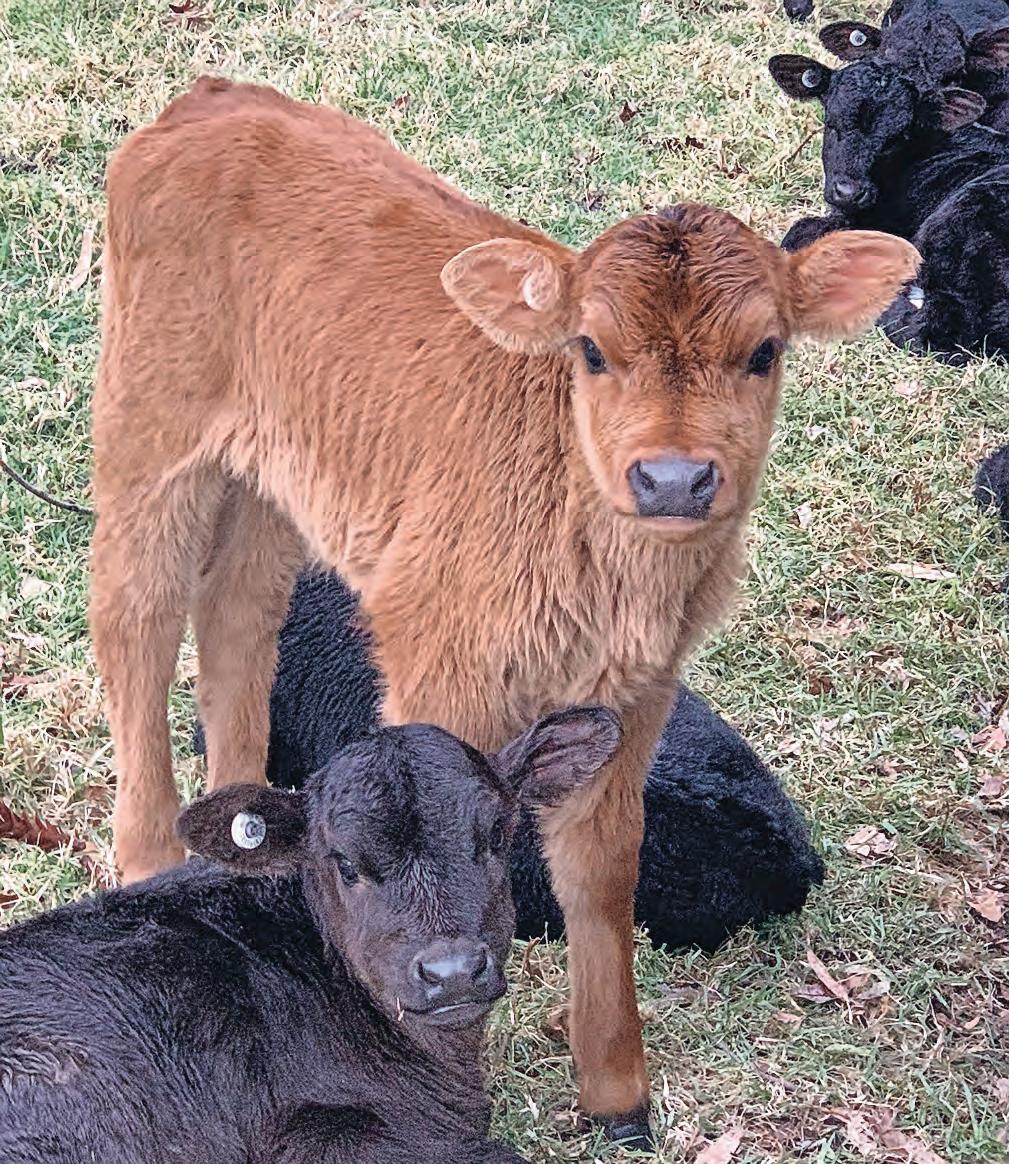
calves. We need to think in terms of their DM intake, even though we deliver it as a liquid: 1 litre of milk equals 125g DMI, so 4 litres of milk/ day equals 500g DMI/day.
We have all the tools at our disposal — milk, water, calf milk powder, and the number of feeds per day. All we need to do is manipulate each of these tools to optimise the nutrition we offer our calves.
Adding milk powders to whole milk increases the level of nutrition per litre, so we can feed fewer total litres but provide more solids to the calf and sell more milk.
The tool we use to aid us in this milk math is the NRC Calculator. It's a free phone app available from most app stores and helps you run different scenarios to see which one gives the best outcome.


Nothing is as good as whole milk; that's why milk processors pay us for it. However, we must consider the other significant change we have imposed on the calf.
Off its mother, it would get that high-fat milk in 8-plus feeds over the whole day. We are trying to squeeze all of that nutrition into two feeds.
Those two big feeds of high-fat whole milk take time for the young calf to digest and, importantly, discourage it from eating grainbased starters. We want the calf to eat starter, as this is what develops the rumen and encourages even faster growth.
To combat this, when feeding whole milk, we use a particular milk powder combination known as a balancer or extender to lift the overall calories and protein intake but try to hold the fat at a level the calf can handle.
Traditional CMRs are high in fat, so they don't help this fat-satiety effect.
ProviCo Rural launched ProviCo ENHANCE into the market in 2023, providing dairy farmers with this valuable tool. ProviCo ENHANCE is 25 per cent protein but only 10 per cent fat, so it uses all the goodness of the whole milk fat but dilutes it back to a level the calf can more easily manage in a twice-a-day feeding system.
ProviCo ENHANCE helps provide the calf with the higher nutrition plan it needs but at 25 per cent of the cost of a premium CMR. In turn, this helps improve average daily gain and, importantly, often lowers the cost of gain in most situations. Even better, improving milk nutrition encourages calves to eat more solid feed (Gelsinger, 2016).
Some rules of thumb
Rules of thumb are dangerous because they can be broken without consequence. However, we should keep them in mind regardless, as sooner or later, we get bitten.
Whole milk is about 12.5 per cent solids (125g/litre). Milk powders are 1g of powder equals 1g of solids. Keep your final milk solution below 16 per cent solids (use water to dilute if needed), ideally below 15 per cent.
The maximum suggested DMI for Holsteins is 1.1kg/day and for Jerseys is 0.9kg/day. Try to get the milk mix protein above the fat.
Using powders with whole milk is called ‘fortifying milk’, a practice used globally. Fortifying with the right powder can significantly improve calf outcomes.
For 60 years the heart of the RENN Roller Mill has been its precisionmachined 16” diameter rolls which provide more grain rolling area per revolution compared to other brands of roller mills with smaller diameter rolls. RENN Roller Mills save time and money year after year by rolling more grain per hour with less horsepower.


In conclusion
Calf rearing can be a time-consuming job, incurring a lot of expense and heartache.
Next time you see a sick calf, don't just look for the bullet (the bug); stop and ask yourself about the gun and the finger on the trigger — it could well be inadequate DMI.
The good news is that the solution is available, improves the outcomes for all your calves, and reduces the cost of gain (but that’s another article).
ɋ For more information on ProviCo ENHANCE, colostrum supplements, milk fortification or calf rearing in general, contact your ProviCo calf specialist. By Hugh Archibald, ProviCo Rural technical and nutrition manager.




What if you could proactively improve calf and cow health sothey can better withstandchallenges, including those caused by mycotoxins?
What if you could control calf diarrhea before an outbreak, and reduce the incidence, severity and duration of other common diseases that affectthe feedconversion efficiency of lactating cows and your bottom line?

What if you could add nutritional insurance to every stage of your cattle’s lives resulting in healthier heifer calves that join the milkingherd ready to contribute at a high level, and lactating cows that spend less time off feed.
Has been shown to:
•Agglutinates and binds E. coli and Salmonella enterica.
• Agglutinate and bind E. coli and Salmonella enterica
•Reduces the incidence, severity and duration of mastitis and cryptosporidiosis infection.
• Reduce the incidence, severity and duration of mastitis and cryptosporidiosis infection
• Reduce blood stress markers during and after transport and temperature stress.
•Reduces blood stress markers during and after transport and temperature stress.
• Minimise cytotoxic damage caused by a variety of mycotoxins and carryover of aflatoxins in milk
• Improve weight gains and performance in calves and milk yields in lactating cows
•Minimises cytotoxic damage caused by a variety of mycotoxins and carryover of aflatoxins in milk.
•Improves weight gains and performance in calves and milk yields in lactating cows.

Distributed By:
The Australian Competition and Consumer Commission’s National Anti-Scam Centre has recently posted warnings for farmers on social media, focusing on hay bale scams.
Scammers advertise hay for sale and ask for a deposit, with the balance payable in cash on delivery. But the hay never arrives and the scammer stops all communication.
While the recent trend focuses on hay for sale, other agricultural related products may be referenced in similar scams.
The ACCC says never pay money to someone you only know through social media.
If you’re making an online purchase, use secure payment methods such as PayPal or credit card.
If you’ve transferred money or shared financial information, contact your bank immediately, and help others by reporting scams to Scamwatch.
According to NASC, in 2023, scams where contact occurred via social media resulted in the second highest volume of

reported losses, increasing by 16.5 per cent from 2022 to $93.5 million.
The ACCC says scammers set up fake profiles on social media, messaging platforms and apps. They pretend to be from the government, a real business, employer, investment firm, or even a friend, family member or romantic interest.
Scammers can also learn a lot about you from details you share on your social media accounts.
Visit the ACCC’s Scamwatch website to find out more, at: scamwatch.gov.au










THE BALE Up Conference 2024 is taking dairy women to new heights and big city lights in September.
NSW Women in Dairy Inc is inviting all women in the dairy industry (regardless of location, experience or age) to attend the three-day event in Sydney, from September 10 to 12.
The main objective of the annual Bale Up Conference is to create a supportive and collaborative community of women in the dairy industry along with its service providers.
The conference strives to connect dairy farmers and create long lasting and meaningful support networks by bringing together individuals from various regions, both within NSW and interstate.



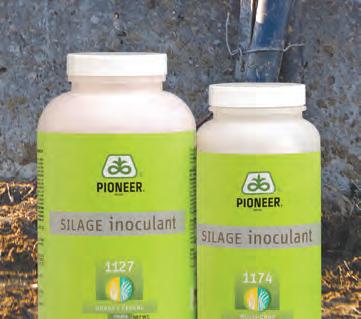

This amalgamation of diverse perspectives helps foster creativity, innovation and a sense of unity among the participants, opening doors to new opportunities and collaborations.
The conference always features a range of sessions, workshops and panel discussions that cover an extensive range of topics relevant to women in the dairy industry.
From practical tips for on-farm management, animal welfare and machinery operation to discussions on leadership, mental health and work-life balance, the program is carefully designed to address the diverse needs and interests of the attendees.
This year’s program highlights include speakers Erin Molan, Simone Kain, Courtney Webeck and many more.


Panels will include Different Dairy Directions, Rural Health, Mind the Gap and Riding the Waves.
The gala dinner on the Wednesday night will be a Sydney Harbour cruise, and optional activities will include a Sydney Harbour Bridge climb, a farm tour of Leppington Pastoral, or high tea at the QVB.
The Bale Up Conference recognises that for women to thrive in the dairy industry, they need access to information, resources and opportunities as well as a supportive network of friends who have been there.
By providing a platform that brings together women from all walks of life, the conference aims to create an environment where individuals can learn, support each other and ultimately contribute to the growth and success of the dairy industry.
For more information and tickets, go to: https://www.nswwomenindairy.com.au or @nswwomenindairy (Faceboook and Instagram).
AUSTRALIAN DAIRY farmers will soon know the best age to calve their Holstein heifers to maximise production, health and reproduction.
And thanks to specialist DairyUP research, the industry will understand what’s best for intensive housed-cow dairy farming systems and those pasture-based operations.
DairyUP researcher Andrew Lean is working to answer one of the long-held industry questions using global data and on-farm monitoring of 429 Holstein heifers across six NSW farms — both intensive and pasture-based.
“The age that dairy heifers calve into a milking herd for the first time can play a significant role in their health, carbon footprint and wellbeing and the economics of a dairy farm business,” he said.
“While many dairy farmers aim to calve their heifers for the first time at two years of age, the reality is that timeframe — according to heifers in the DairyUP database — can range from 24 months in an intensive system and up to 26.5 months for a median age at first calving at pasture-based operations.”
A global literature review conducted as part of the DairyUP project revealed the age at first calving globally was 24 to 28 months.
This same review also highlighted some benefits for those calving younger.
For example, research showed improved calving ease for heifers with an age at first calving of 18 to 22 months.
Very early data indicates a higher pregnancy rate in the group of heifers bred at 12 months of age, compared to those bred at 14 months of age or older.
Concerns about lower production in a heifer’s first lactation — potentially due to earlier calving — also wasn’t a concern because her lifetime production is greater, and she has less “unproductive” time.
It’s only early days in the DairyUP on-farm research, but Andrew said there were already some signs about the benefits for breeding heifers earlier.
“Very early data indicates a higher pregnancy rate in the group of heifers bred at 12 months of age, compared to those bred at 14 months of age or older but this is subject to further analysis of a complete dataset,” he said.
These heifers will continue to be monitored throughout the coming year, but Andrew said this work was a great reminder for farmers about the importance of optimum nutrition for young stock to enhance their growth.
In addition to solving the industry’s age-offirst-calving mystery, this research project will also concentrate on heifer hormonal and metabolic influences at, or around, puberty; the effects of nutrition and environment on the production, health and reproduction of housed cows; as well as the role of microbial enhancers in compost bedding quality and what this does to cow behaviour.
For more information, go to: https://www. dairyup.com.au

Early findings from DairyUP’s on-farm research have suggested a higher pregnancy rates for Holstein heifers bred at 12 months of age compared to those bred at 14 months or older.





to calve for the first time to maximise production, health and dairy business economics.







We understand that farm life’s all-consuming. So, in 1977 we were the first to invent cow monitoring solutions that not only maximise dairy herd performance, but also minimise workload and stress to restore work-life balance.




Experience why the world’s top milking equipment and genetics providers choose to partner with Nedap. “Powered by Nedap” means the most reliable and innovative cow monitoring technology, complemented by the great value arising from its integration with their unique solutions. Together, we help you get the most out of your results and life on the farm.
Learn more and find your Nedap distributor at nedap.com/farmlifeAU
balance


LIZZY CHAPPELL fell in love with farm life 15 years ago, joining her then high school sweetheart Brian on his family farm.
Under the guidance of Brian’s mother, Lizzy discovered her passion for farming.
Now the down-to-earth 27-year-old works every day alongside her fifth-generation farmer husband Brian on their northern NSW property, as well as raising their three children Luke (5), Jacob (3) and Amelia (1).
Brian’s mum shared with Lizzy the ins and outs of dairy farming and passed on the knowledge she had learnt throughout her years as a dairy farmer.
“I fell in love with the farm and farm life, as previously I had only been a hobby farmer in my hometown of Clunes and had no family history in farming,” Lizzy said.
Lizzy and Brian first entered a partnership with Brian’s mum and stepdad four years ago, however due to unforeseen circumstances with Brian’s mother falling ill,
they took over and have been running the farm together ever since, making them one of Norco’s youngest suppliers.
“It happened sooner than we expected as we are still quite young, but we felt ready and well prepared,” Lizzy said.
“Brian’s mum was so knowledgeable, she taught me everything I know including how to bring up the best cows possible and run an efficient farm.”
Lizzy and Brian currently employ five staff members and manage a herd of 750 cows in total, with 400 milking Jerseys.
As the couple is also raising three children, the farm is family focused — not only for Lizzy and Brian but for all staff members.
When asked what she loves most about being in the dairy industry Lizzy said bringing the kids up on the farm was an amazing experience and the joy it brings to their whole family is priceless.
“The boys absolutely love it, and they already talk farming,” she said.
“They feed the calves and help us out, where it’s safe of course. I love the farming lifestyle and sharing it with my kids.”
Being one of Norco’s youngest dairy farmers and a woman, Lizzy has found a great support network of fellow female dairy farmers from farms close by and a Women in Dairy Facebook group which serves as a place for sharing tips, advice, and interesting news updates.
When asked what a day on the farm looks like for Lizzy, it’s a 3.30am start to milk the cows, before getting Luke and Jacob ready for daycare. Then it’s back to the farm for chores throughout the day while caring for Amelia, her youngest.
“I will be honest, I am not hands-on or confident with the machinery so I leave that to our staff,” she admits.
“Maybe one day I will learn. But really my passion lies with innovation on the farm, caring for our herd and striving for success.
“The innovation we have implemented on our farm comes from a real love for our cows.
“We have introduced collars for cow health which will connect to the Autodraft, a chip in their ear with a personalised number.
“This will tell us if a cow is sick or on heat when it walks past the scanner and we can tend to it immediately, enhancing on-farm efficiency.”
Lizzy and Brian also received a grant to create a big dam on-farm for effluent recycling and have plans to upgrade their farm in the future.
Lizzy hopes to pass down her knowledge to her children as they get older, showing them the ropes of dairy farming.
“I love seeing my kids grow up on the farm and I hope that maybe one out of the three will catch on to my enthusiasm for the dairy life and become a dairy farmer.
“After all, there is nowhere else I would rather be.”

J. Furphy & Sons Pty. Ltd. is a proud fth generation, familyowned Australian manufacturing engineering business, located in regional Victoria, servicing Australia and beyond. Employing over 200 people, including design engineers, quali ed fabricators, galvanisers, and investing in our own local apprentices.
Furphy‘s iconic position in Australian culture commenced with the development of the cast iron water
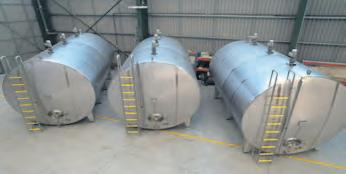

cart used in military camps during the First World War. This legacy continues with our Furphy Water Carts. Proudly still manufactured today in our Shepparton facility.
Our carts are a robust solution for transporting water or diesel with a carrying capacity of 950 litres and available for instant delivery.
Furphy Engineering has taken the Water Cart concept to the next level of; design, engineering and manufacturing of specialised,


high-quality stainless-steel storage tanks, processing tanks, pressure vessels and more. Our iconic tanks often take centre stage on many of Australia’s critical food, dairy, brewing, manufacturing, pharmaceutical, chemical, oil and gas and other industry facilities.
To remain at the forefront of Australian manufacturing, Furphy Engineering’s continuous focus on innovation, an example of this, is our “Dimple Q”, laser-welded dimple
(or pillow) plate, which provides an innovative and cost-effective heat exchange solution.
Furphy Fabricated Products, offer an extensive range of engineering and fabrication services, ranging from concept, design, estimates, sourcing of raw materials, laser cutting, beam cutting, total fabrication & assembly, galvanising, distribution, and project management.





Unparalleled heat detection.















BY JEANETTE SEVERS
FARMERS NEED to be aware of the tax implications of writing assets off in the year of purchase, compared to depreciation, a taxation accountant advises.




This was particularly relevant because the Federal Government, through the Australian Taxation Office, was continuing to offer the option to claim an immediate deduction on the cost of an asset purchased during the year. This includes assets purchased for combined business and personal use.
In the case of an asset purchased for combined business and personal use, the maximum $20,000 write-down amount could only be applied against the assets’ business use.
Farmers commonly purchased assets that were used for the farm business and personal use.
The 100 per cent instant asset write-off enabled up to $20,000 of that asset to be claimed in the year it was purchased, so long as that value applied against business use.
If a farmer wants to utilise the instant asset write-off, they will only accrue a tax concession against this asset in the financial year of purchase.
But this had tax concession implications, according to Ken White, accountant and principal of White’s Accounting and Taxation Solutions in Bairnsdale.
Depreciation enabled the value of an asset to be written-down over a period of years.
“Machinery, plant and equipment are depreciable over years,” Ken said.
“The depreciating value of these assets can be applied annually as a tax concession against the business.”
But if a farmer wanted to utilise the instant asset write-off, they would only accrue a tax concession against this asset in the financial year of purchase, Ken said.
He recommended farmers discuss this with their accountant to ensure they understand the implications of either decision on their farm business.

BY JEANETTE SEVERS
THE DAIRY industry is a solid investment over time for growing wealth.
That was the view of a banker who spoke at a farmers’ seminar held at Bairnsdale recently.
The seminar hosted a panel of speakers who discussed family farms and business growth, succession planning and tax implications.
Chris Kooloos is a senior agribusiness manager with National Australia Bank. He was raised on a dairy farm in NSW, and a brother owns a dairy farm in South Gippsland.
“The bank’s role is about helping people to build up equity and build up asset ownership,” he said.
“Transferring ownership of assets is about accessing capital, and providing capital is the bank’s role.”
Chris said there were multiple pathways to build equity and therefore wealth in the dairy industry, before investing in land ownership or expensive machinery.
People could leverage capital through banks to buy cows and add these into the herd they milked, if their arrangement with the farmer enabled that.
Chris said this was a pathway favoured by farm workers, aspiring sharefarmers, lessees and farmers’ children — adult or underage.
Buying cows-in-calf enabled them to leverage further equity, as the value of their investment effectively doubled within a few months.
Chris said bank staff could also advise on how to leverage one generation’s assets to benefit the next generation.
“This enables lending by leveraging equity for the next generation through the joint arrangement of ownership,” he said.
This was particularly helpful when succession planning enabled multiple generations of the family to be in a formal business partnership.
“Depending on the formal nature of that partnership — it could be a family or unit trust — this demonstrates to banks that there is joint or shared ownership of the farm’s assets,” Chris said.
“A plan identifies the financial roles and expectations set up for each generation — identifying who’s involved in the business, and who’s making decisions about the business.
“This can help the bank to make decisions about helping the next generation to grow their assets especially to take over the farm when that time comes.”


-
PHONE: 03 5662 3277 EMAIL: pgoiris@dairytechrefrig.com.au
WEB: www.dairytechrefrig.com.au



• WiSA’s automated irrigation system can deliver water when required and on time
• WiSA’s wireless solution means you have total control from your mobile phone or computer
• WiSA improves water use efficiency and can reduce labour costs
• WiSA’s automated irrigation system can improve the sustainability of your dairy farm, vineyard, orchards, and fields
1300 887 380








BY JEANETTE SEVERS
APPARENTLY, THE muzzle of a cow is nearly as unique as a human’s fingerprint.
This knowledge has led to the global development of facial recognition software for cattle.
In Australia, University of New England computer scientist Dr Ali Shojaeipour developed artificial intelligence tools to identify individual cattle with 99 per cent accuracy using their muzzle patterns.
Facial recognition software identified small variations in the shape and patterns of the cattle’s muzzles.
Ali was able to build a self-learning biometric identification model that was capable of continually adapting as new data was entered via new photos of additional cows.
His initial modelling using 300 cows indicated 99.11 per cent accuracy of muzzle identification.
However, in a UNE article in 2021, Ali said his technology needed further development to ensure accuracy in the manure and dirt reality of farms, feedlots and saleyards.
Now Dr Phillip Zada, CEO of Australian software engineering company Stoktake, has developed the technology that ensures accuracy even when a cow’s muzzle is covered in manure.
He is taking Stoktake onto the farm, with a research project at Ellinbank Smartfarm, the

dairy industry’s leading research farm in West Gippsland, Victoria.
Stoktake, like other livestock facial recognition programs developed in recent years, is designed for farmers to take photos or videos of their cattle using their smartphone or tablet.
Stoktake also integrates across other software programs such as those providing animal


*0% over 36 month finance is offered on new Bobcat telehandlers on a chattel mortgage with 10% deposit required, followed by equal monthly repayments and no balloon. Finance is subject to credit approval and is only available to approved ABN holders. Not available in conjunction with any other offers. Terms and conditions apply. For further details, contact Clark Equipment.





management, feed, fertility and productivity data for each cow.
Dr Phillip Zada is also the Z Ware CEO, a company which designed the software engineering program as part of a brainstorming session, or hackathon, between employees.
“We do a hackathon every few months in our workplace, trying to develop workable
solutions against technology challenges,” Phillip said.
“I invited Ali to work with us, and in the early days of the project, we were able to use some of his research.
“Not only were we able to develop Stoktake and get it to work, we were able to get it to work differently to anyone else.
“It will work even when there is dirt or manure on the cow’s muzzle.”
Stoktake’s initial database of 500 cows was built through field tests and pilot programs, then expanded to 1500 cows, with a 99.65 per cent match rate on the muzzle.
Phillip said a mix of corporate and government funding had enabled global trials in countries including South Africa, Botswana, Brazil, the United States, and others – leading to a database of 25,000 dairy and beef cows.
Now Dairy Australia is funding a research project at Ellinbank Smartfarm using Stoktake.
“The interest has come from small and large producers – the small producer with 30-40 cows is just as interested as the larger producers in Brazil with half a million cows,” Phillip said.
“Every country has their own issues with stolen cattle. Some countries like Australia have a national registration system, some don’t.
“One of the most common technologies out there are eartags. But when cows get stolen, it’s not that hard to take the eartag out.
“This is also a non-invasive technique that works.”

In Australia, research by PwC has identified an estimated 28,000 cattle are stolen each year, at an estimated $105 million annual cost to the industry.
This data is across the Australian dairy and beef industries.
In Australia, most livestock theft that is reported remains unsolved, and experts state a lot of livestock theft is underreported.
Unlike in Australia, in some countries like the United Kingdom, there has been a growth in reports of livestock theft because insurance companies require a correlated theft report from police to meet their obligations as insurers.
“After trialling Stoktake against crime in several countries across 12 months, we know it works effectively,” Phillip said.
He spent time last year liaising with police, academics, farmers and others to develop Stoktake as a solution against crime for Australian farmers.
One of the first challenges working with dairy cattle at Ellinbank was to sort out the assumptions within Stoktake.
“We’ve been experimenting with camera placements and in different lighting and weather conditions,” Phillip said.
“One of the things we uncovered at the beginning was the cows at Ellinbank came through the yards to the dairy about two hours later than we expected.
“This meant the lighting in the yard wasn’t ideal for identifying cows by muzzles.

“We realise we need to improve lighting in the yard, given when cows generally come into the dairy for milking.
“But in the bale, there was sufficient lighting to identify the muzzle.
“So the first stage of this project at Ellinbank has been about identifying the best placement for the cameras.”



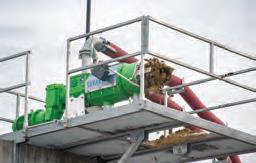
Stoktake technicians have been identifying the best placement for cameras that, firstly, take the initial photo of the cow, and secondly, from then use the engineered software algorithm to facial recognise the cow.
Stoktake can be integrated with other livestock management systems, meaning it can be part of the program on a farm that is already correlating
herd management, fertility and reproduction data, feed management, vaccination records and other health data, weight and fat scoring, location on the property and sales data.
“It was built for integration with other software programs.
“It also has the potential to identify cows that are coming through the yards that shouldn’t be, because they’re sick and are supposed to be milked separately,” Phillip said.
He said Stoktake can be used offline.
“In Botswana, farmers recorded videos and photos of their cattle on their phones, then uploaded that information to the database when they have a mobile connection,” Phillip said.
As well as the research project using dairy cattle at Ellinbank Smartfarm, Stoktake is scaling up this year through two additional partnerships – one in Brazil involving 170,000 head of a mix of dairy and beef cattle, and one in South Africa with 50,000 head of a mix of dairy and beef cattle.
Phillip and his team also took Stoktake to The Startup Network’s Climate Tech and Ag Tech Pitch Night in May this year and won, which takes them through to the 2024 Australian Agritech award in late July.
Phillip said there was an Australian patent pending confirmation for Stoktake in its final stages.
*There are a number of facial recognition technologies being trialled and used in countries including Australia.


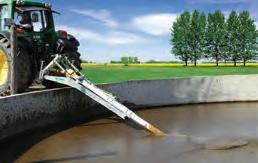





























































to cut your feed wastage and save you money. The endless troughs can be laid in a continuous length, they are also stackable, so you can move them easily from one paddock to another. The frame is made from Australian Steel, with repurposed rubber conveyor belt used to make the trough, its nylon based and will last a lifetime.







IT’S BEEN eight months since Willows Pastoral began operating under an automatic dairy milking system.
Farm owners Nigel and Jess McNeil now milk their 200 cows with the help of Nigel’s dad, Wayne, using their four GEA DairyRobot R9500s in their upgraded facility.
The McNeil family started farming in Murrabit, near Kerang in northern Victoria, 80 years ago.
As Wayne prepared for retirement, Nigel took over the dairy farm, recognising the need to upgrade their existing dairy facility, which required two operators.
The main goals were to manage labour shortages as Wayne exited the farm and transitioned into retirement, maintain premium milk quality with low cell counts, and achieve a better work-life balance.
Nigel chose the GEA DairyRobot R9500 for its compact design, which easily integrated into their current facility.

The GEA DairyRobot R9500 was the perfect solution due to its small footprint, ease of integration, and labour-saving benefits.
The technology also represents a significant leap forward in sustainable dairy farming practices.
This automatic milking system offers up to 19 per cent energy savings, reduced water consumption, and shorter milking times compared to the predecessor model, making it both economical and environmentally friendly.
“We only need one supply unit to connect four boxes, sharing equipment and reducing system complexity,” Nigel said.
Its In-Liner Everything technology ensures high milk quality by performing every step of the milking process within a single attachment, maintaining hygiene and efficiency.
The DairyNet App herd management system allows the McNeils to monitor cow data and system parameters anytime, anywhere.
Nigel has also decided to integrate the







CowScout herd management system to optimise cow health, heat detection and reproductive management.
“The data we get is incredibly helpful. It makes managing the herd so much easier and more efficient."
Wayne now enjoys the flexibility of running the farm solo on weekends, while Nigel can spend more time with Jess and their three children, confident that the milking robots are handling the cows efficiently.
Their story is an inspiring example of embracing innovation to create a sustainable and efficient farming future, preserving their legacy and enhancing the farming lifestyle for future generations.
On July 9, the McNeil family opened their doors to about 80 visitors, including farmers, suppliers, industry enthusiasts and partners.
The visitors had a chance to see the GEA robotic milking system in action and hear from the farm owners about the challenges and opportunities they encountered while transforming their facility into an automatic milking dairy with a digital herd management system.
Representatives from the GEA Farm Technologies and Dairy Technology Services Kyabram dealership, who supplied and installed the milking system, co-organised the event and were available to answer questions related to farming equipment and solutions. The day was filled with learning, knowledge exchange and engaging conversation.
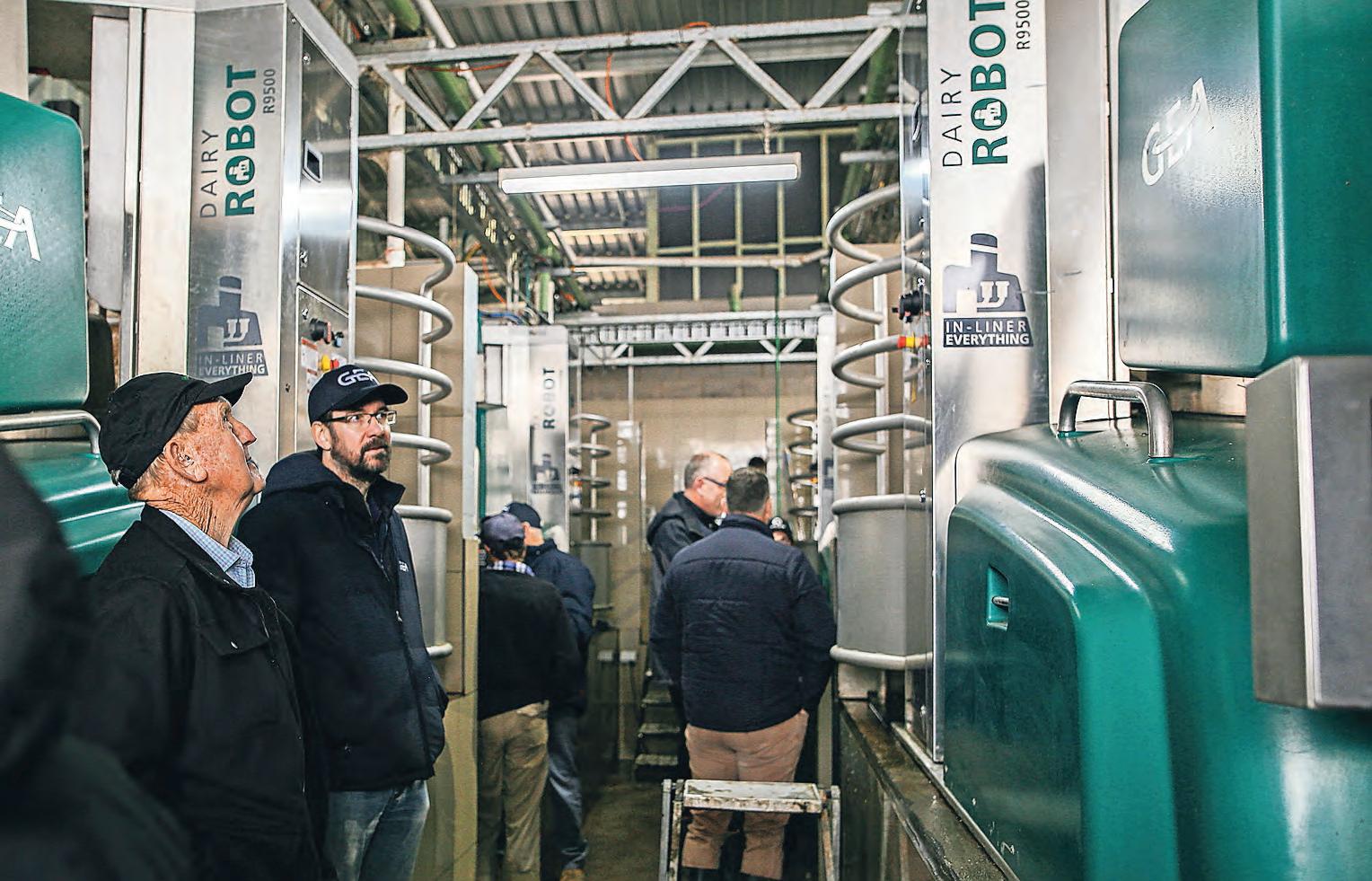




BY JEANETTE SEVERS
CINDY MORRISON is the new marketing and communications adviser for the Victorian Dairy Innovation Agreement.
The Victorian Dairy Innovation Agreement (VDIA) is a collaboration between Gardiner Foundation, Dairy Australia and Agriculture Victoria.
Its role is managed by a board with representatives from the funding partners and employs general manager Clare Hill, and Cindy Morrison.
Dairy Feedbase has just begun its second five-year funding cycle and much of the research is undertaken at the SmartFarms at Ellinbank and Horsham.
DairyBio, through a partnership with La Trobe University, is a five-year investment program focused on science to improve pastures and dairy herds.
DairyBio is providing the research pipeline to quantify the value of genetic testing for improved cow and calf health.





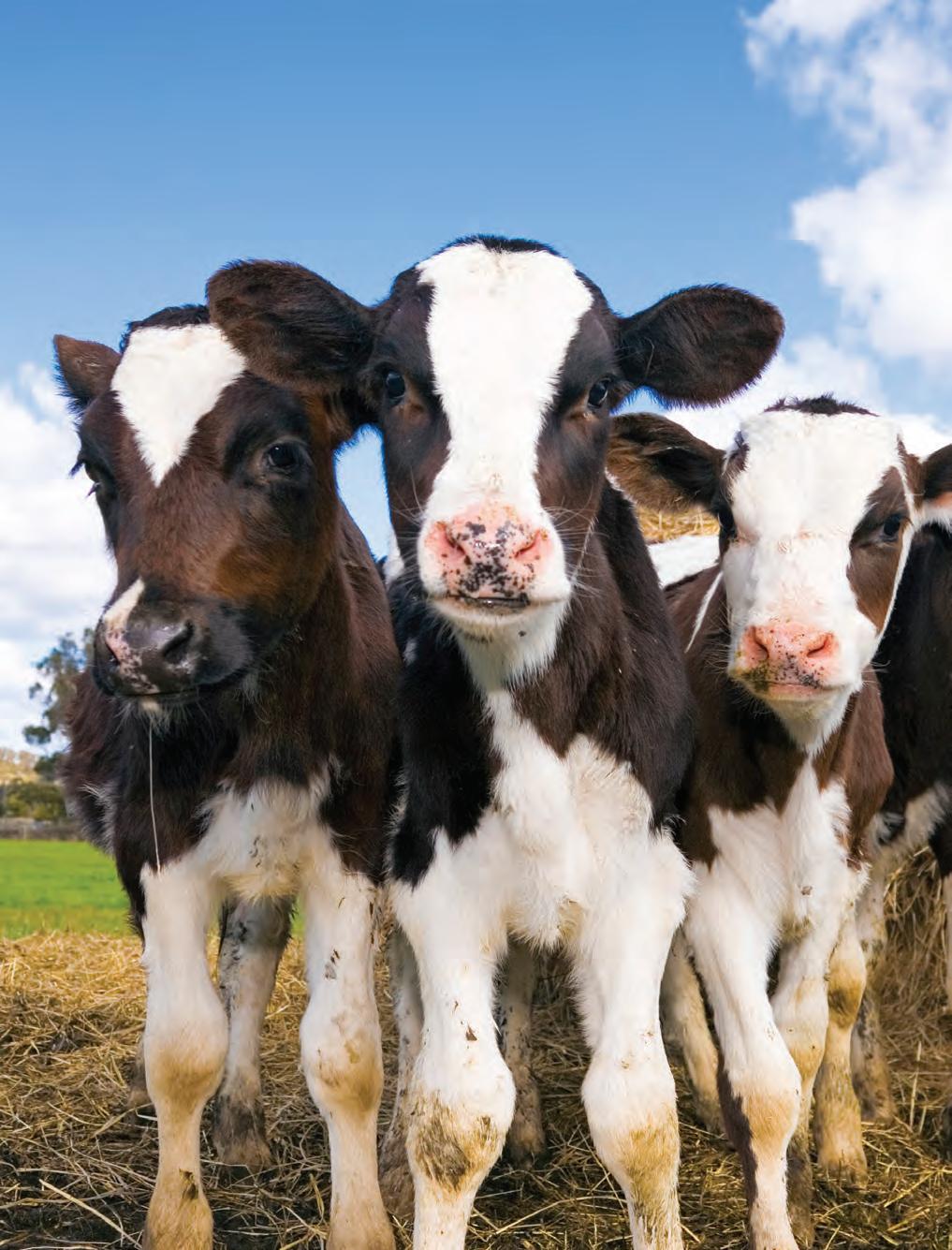
The VDIA oversees the direction of research and innovation funding through DairyFeedbase and DairyBio projects.
DairyFeedbase focuses on research about cow health and nutrition, herd feeding and forage productivity through soil health and fertility and crop management.

Cindy attended the Ellinbank SmartFarm in July, during the open day hosted by Dairy Australia. Her role with VDIA is to organise researchers and scientists to host webinars and speak on podcasts about their work, and collaborate to distil that information into articles for Dairy Australia publications.
Cindy is also organising conferences for farmers to hear about the results and outcomes of research projects.

BY DR LES SANDLES
CALL ME a contrarian — you wouldn’t be the first! We all understand the gist of the saying ‘make hay while the sun shines’ but few do.
This is for three key reasons: first, that our shopping list of wants and needs grew while there wasn’t enough money; second, we quickly adapt our expenses to fit the looming higher income (this phenomenon is true also of the wage and salary earner); and third, we are comfortable and so it’s easier to take it easy while the money rolls in.
The truth of it is, that comfort robs us of the necessary motivation to change — so we rarely get full advantage of the good times, which leaves us vulnerable when things go bad.
Thus, the fondness business coaches in the corporate world have for the Churchillattributed quote: “Never let a good crisis go to waste”.
I can tell you from my consulting experience, that a crisis is indeed, a gift.
Only when there was a crisis — be it the bank knocking on the door, a disease outbreak, a failure in the repro program, or (God forbid) having other discussion group members’ production racing past yours — was my advice rapidly adopted.
Discomfort, however it presents, is the only consistent motivator for change.
You see, we humans are little different to most animals — we are inherently lazy. And since change requires effort, well, it’s easier not to.
And so, in this reframe, our beloved dairy industry has just delivered us a gift.
It has dropped the farm gate milk price from an average $9.51/kg last year to — depending on supplier — $7.95 or thereabouts. This is a very significant 16.5 per cent.
Our immediate reaction is one of anger, or disappointment, but let’s put this into perspective:
ɋ the milk price has been at record levels for the past couple of years; and
ɋ this is nothing compared to the Goulburn Valley’s SPC suppliers who have been told only about half of the fruit crop they grow will be taken next year.
Thus, our situation is probably more uncomfortable than desperate, but nevertheless, is prime motivation to do things differently.
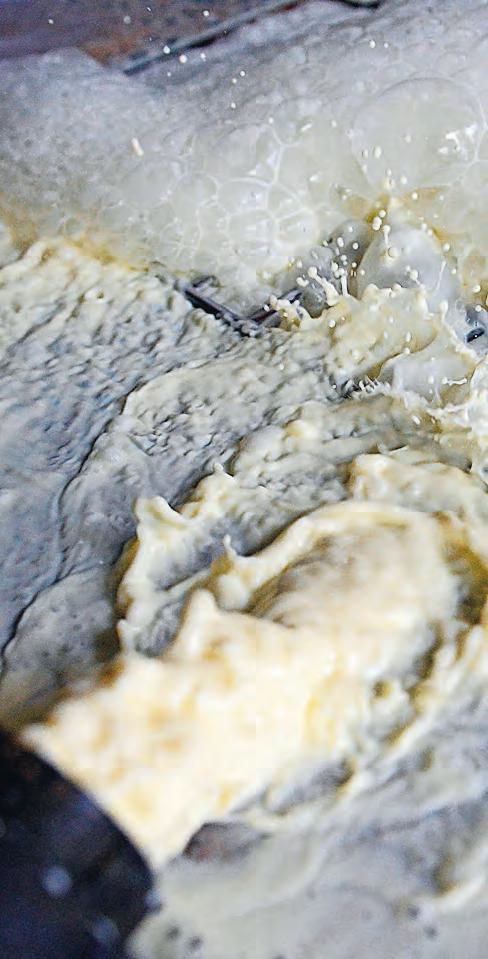
Wait, there’s more.
We also have a looming cataclysmic event — climate-related regulations on both inputs (N and P) and outputs (greenhouse gases, particularly methane and nitrous oxide).
What better opportunity do we have to plan a ‘green’ future — to reinvent our production system to meet future needs in a manner that produces major cost reductions while increasing productivity, commensurately ensuring future sustainability within the new climate framework.









Until recently, I would have considered this impossible, but a home-grown Aussie technology is currently exciting governments and producers around the globe because it is doing just this.
The key is to understand how you might create an on-farm circular economy — that is, using your farm’s organic waste as the resource to replace a good chunk of your fertiliser and chemical inputs.
Climate change, global warming, the carbon crisis — call it what you will — is going to


















massively change the way we farm. Like it or not, we will have to change the way we conduct our farming practices. We can wait until the supermarkets or your milk processor or the government or the bank forces the change (which is highly undesirable), or we can transition at a slightly uncomfortable, but perfectly manageable pace.
I favour the latter.
ɋ If you would like to know more, drop us a line at: info@4sight.bio












BY DR ROBERT BONANNO
SPRINGTIME IS commonly associated with calving time and it is well known that the three weeks either side of calving, also known as the ‘transition period’, can make or break a dairy farm for not only this season but for many more to come.
Transition is the critical time when a cow is preparing for calving and the next lactation, and once she calves, establishing a new lactation.
There is a lot happening during this critical time.
In the final weeks of the dry period, a cow’s udder begins to produce colostrum, the vital first milk that is rich in antibodies and other valuable nutrients that will set a calf up for lifelong success if it receives enough high-quality colostrum as soon as possible after birth.
Because a cow’s placenta does not allow antibodies to pass directly from her bloodstream to the calf, the failure to provide enough colostrum in the critical first few hours of life will result in a failure of the passive transfer of immunity from the cow to the calf and a calf that is at greater risk of disease.
Research consistently supports the fact that improving our efforts to achieve this passive transfer will have both immediate and lifelong benefits to the calf.
The other important considerations that need to be addressed in the vital last few weeks of the dry period is rumen adaption to the
lactation diet and managing the risk of metabolic diseases like milk fever and ketosis.
A common strategy that is often very successful is the use of ‘lead feeding’.
This is a sometimes confusing term because it is not always clear whether the lead feed is being fed to manage milk fever, adapt the rumen or do both of these important roles.
With the development in recent years of alternative lead feeding strategies to the typical anionic salt DCAD diets, I see a bit of confusion in the field as to exactly what is the best lead feeding strategy, how long it should go for and how we can monitor the success or otherwise of the transition feeding.
In short, the best lead feeding strategy that you can implement is one that will work with your particular farming system and infrastructure.
There are several options that you might consider after discussion with your herd’s nutritional adviser and veterinarian, but the bottom line is that there are very few circumstances where some type of transition or lead feeding strategy will not benefit the cows, as long as it is done well.
The benefits in reduction of metabolic diseases are often the most visible and obvious (less milk fever cows treated) but the biggest financial gains can be in the reduction of the sub-clinical milk fever and immune suppression that contributes enormously to what I usually refer to as the ‘transition diseases’ — retained membranes (RFM), dirty cows (metritis and endometritis) , ketosis and LDA.



There will be improvement in early lactation performance leading to higher peak production and milk yield and a significant gains in subsequent fertility is also associated with a smooth transition
Any disease event that occurs in those critical early weeks of lactation can set in chain a series of events that can have serious longterm implications for the cow’s health and the farm’s profitability.
Even a lameness or mastitis event in early lactation will have serious impacts on how a cow performs for the whole lactation.
A cow whose transition is interrupted by metabolic disease, poor rumen adaption to the lactating diet, sickness or illness will have a reduced feed intake and this will lead to her being in a state of negative energy balance.
This negative energy balance will cause her to mobilise her body fat reserves, causing body condition loss and putting her liver and already depleted immune system under considerable stress.
The more body fat she mobilises to make up the shortfall between her intake and the output in milk and activity will determine the consequences.
In worst cases, she can develop a fatty liver and/or ketosis which will often lead to displaced stomach or death. In most cases, however, the ketosis is mild and the real cost is the reduction of potential lactation performance, reduced fertility, increased lameness and increased transition sickness.
Transition management is another example of where proactive health care is far superior to reacting to diseases that occur.
I encourage you to consider discussing with your herd health veterinarian how you might be able to improve the management of your transition cows to reduce the risk of those critical few weeks of every cow’s life.
Dr Rob Bonanno is a ProDairy regional veterinary lead based in Gippsland, Victoria.
New scientific research in a commercial dairy herd has shown how feeding a microbial supplement can increase milk production and liveweight gain.
Developed by Terragen, MYLO is an easy-to-use liquid feed supplement that contains a proprietary blend of live microbes, Lactobacillus casei, Lactobacillus buchneri and Lactobacillus paracasei to improve cow health and productivity.
The study — published in international, peer-reviewed journal Animals — involved 150 milking cows in Harrisville, Queensland, tracking their performance over 16 months.
“This study is the first to investigate the effect of uninterrupted supplementation of a Lactobacillus direct-fed microbial (MYLO) over two lactation cycles in a commercial setting,” Terragen chief operating officer and veterinarian Dr Joss West said.
“Using a commercial property with university collaboration meant we could reliably test the product in conditions which are comparable to what farmers would see in their own herds.”
average of 0.39 litres per day more milk than those that were not.
“That’s a three per cent increase in the first 100 days in milk and a predicted increase in milk production of 258 litres per cow over a full lactation for the cows supplemented with MYLO,” Dr West said.
“The results show that using microbials can have a significant impact on production, improving profitability on farm.”
The cows fed MYLO also gained more liveweight, an average of 19.4kg, over the study period. In the critical period after calving, these cows lost less weight than the control group, maintained a better body condition and recovered bodyweight sooner.
“Cows face significant metabolic stress after calving and energy demands are greatly increased due to the start of lactation,” Dr West said.
ProDairy can assist you with the development of a tailored plan:
• On-farm visit by a ProDairy veterinarian.
• Review of the current biosecurity principles, the major risks and actions taken to reduce those risks.
• Development of a customised biosecurity plan.
Visit prodairy.com.au for more information.

The Holstein cows were fed a partial mixed ration during the day and grazing pasture at night; 75 of them were also given a daily 10ml dose of MYLO Cow.
The researchers recorded milk production and liveweight gain from September 2021 to January 2023, starting in mid-lactation of first production year (2021-22), through the dry period and into late lactation in the second production year (2022-23).
The research found the benefits of MYLO really started to show after calving.
In the second production year, cows fed the liquid feed supplement produced an
“Body condition management is key to ensuring the cow has enough energy stores to contribute to increased milk production as well as recovering from calving and it’s well documented that body condition also contributes to reproductive performance.
“We believe our microbes enhance ruminal digestion, ensuring the cow is getting the most from her diet.”
Both the control group of cows which received no additive, and the group fed MYLO, were managed in the same way, with milk yield and liveweight recorded daily.
The research, ‘The E ect of a Direct Fed Microbial on Liveweight and Milk Production in Dairy Cattle’ was funded by Terragen and published in the peer-reviewed journal Animals 2024, 14 1092.
THERE ARE two aspects to making quality hay — starting with quality forage, and curing the forage to the appropriate dry matter content in as shorter time as possible.
When to cut forage for hay is a trade-off between quality and quantity. As the crop or pasture develops a seed head and reaches maturity the yield increases, however the quality declines.
The quality decline is a result of decreased metabolisable energy and crude protein, along with an increase in fibre. However, with cereal crops for example, it can be hard to cure if cut before the seed head has fully emerged.
Project 3030, which was run in the early 2000s, showed it was possible for a wheat yield at the boot stage to yield 7.9 tonnes dry matter per hectare with 10.2 megajoules of metabolisable energy per kilogram of dry matter.
At the soft dough stage the yield increased to 10.9 tonnes dry matter per hectare, but metabolisable energy dropped to 9.3 megajoules per kilogram of dry matter.
Cutting height of 15cm is normally recommended for cereal crops. Cutting higher will increase the quality but reduce yields while cutting below will increase yields but reduce the quality (with increased stem).
Leaving 15cm also allows for the curing fodder to sit on the stalks, allowing airflow under the windrow, reducing curing times and decreasing potential contamination from dirt and rocks.
Once the forage is cut the aim is to get the forage to the target dry matter content in as shorter time as possible to reduce dry matter

and quality losses from plant respiration and potential rain damage.
To quicken the curing process, cut after the morning dew has lifted. Cut with a mower conditioner to crush the stems and nodes, to increase the rate of moisture loss. Leave the windrows behind the mower as wide as possible (75 to 90 per cent of the mower width).
A tedder can be utilised to further spread the forage, reducing the thickness of the windrow
and fluffing up to aid early drying.
Ideally hay should be baled at 10 to 15 per cent moisture. Hay should not be baled over 18 per cent moisture as there is risk of spoilage from microbial activity and the heat generated may result in hay fires.
A practical method of determining if cereal hay is ready to bale is to take a tightly bound handful of hay and wind it rapidly in a circular motion to produce shearing. If it doesn’t break within three
turns it most likely isn’t cured enough.
A representative sample from across and underneath the windrow should be tested prior to baling.
Nodes and seed heads are normally the last parts of the plant to fully cure. Nodes can be checked by squashing nodes onto a flat dark bar and if moisture is left behind it is not yet ready to bale.
Agriculture Victoria












BY ANDY WILSON
THERE ARE two schools of thought with silage. One involves its nutritional advantage over hay, particularly in terms of it being a feed of much higher quality.
However, that is offset by it selling for less due to the higher water content which reduces feed per tonne transported.
Its storage advantages over hay are made obvious by the plastic wrap but ideally production on-farm reduces both the cost and risk of damaging the wrapping in transport.
Although Erin Kelli at Kotta, in northern Victoria, mainly produces hay for a larger profit, she does take opportunity in the event of any wet weather to make silage.
“You take opportunities from the rain. Farmers cannot always stick to a rule because the weather doesn’t always play that game,” Erin said.
“If you do that, then you won’t make it, and we are often sent in to rescue a farmer’s ruined crop.”
Erin works for Paul ‘Quinny’ Quinn and, with Paul’s two sons Michael and Christopher, they start contract work at Deniliquin, in southern NSW, each growing season and work their way south, with 36-hour ‘days’ quite common.
This year, Erin is growing vetch specifically for silage.
“And the first cut off our lucerne always goes to silage,” she said.
“But silage does not pay per ton as well as hay — so it’s generally not worth a lot.”
Adam Whipp from AW Ag Contracting is widely known for his high quality fodder in which he takes great pride, having successfully muscled into the fodder industry.
Adam produces silage on his own land and contracts his services to as far away as South Australia.
The majority of his production is in northern
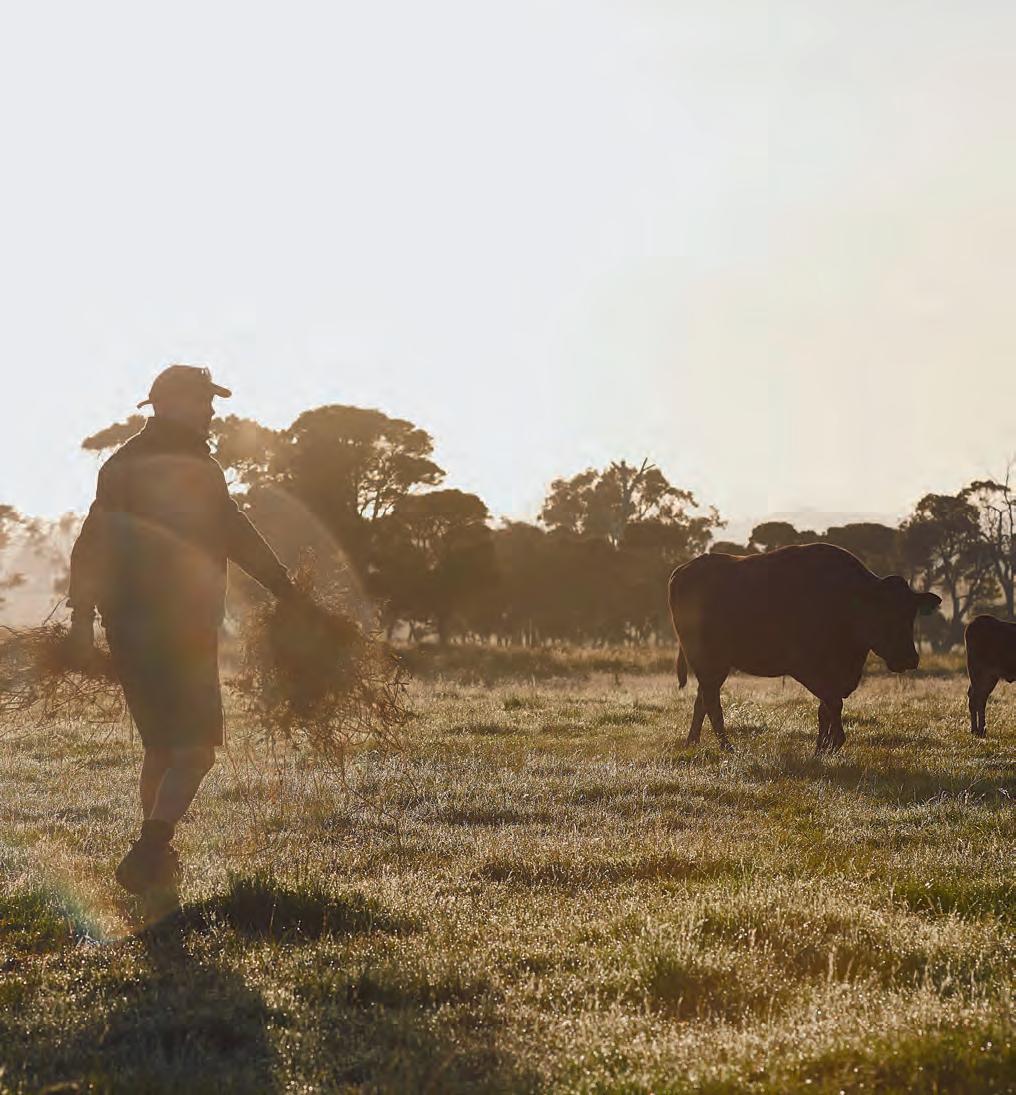

Victoria and the southern Riverina, and he takes advantage of an associate’s export processing plant in southern NSW to export cereal hay to China and Taiwan.
“Our season has a big spread over time and area,” Adam said.
“We produce from September through to November and produce pasture, cereal and vetch silage.”
He also runs a 200ha, 300-head dairy farm at Timmering, in northern Victoria, with fodder production on adjoining land.
“People take the option of silage over hay because there is less risk,” Adam said.
“Last year we grew a lot of maize for silage when the water was cheaper but the yield was down because the summer wasn’t all that hot.
“Which was a lot better than the year before when flooding made it difficult to access.”

Erin took Dairy News Australia for a tour of the different fodder crops starting their prespring surge, having moved that morning a mob of sheep from a lucerne paddock, mid-graze.
“We get the sheep to really flog this lucerne down as low as possible,” she said.
“And then we spray it to die it back to the surface — and that’s something that scares a lot of farmers. But it grows back with its softer, lusher young leaves.”
The farm produces typical rounds of silage, but the biggest silage production is that of large rows of squares cured under tarps, which are loaded straight into chopper trucks and sold directly to farmer feed pits.
Among the machinery at rest for mid-winter maintenance and cleaning is the Swing Max double baler — one of three in Australia — which can arc an arm out for widely spaced windrows.































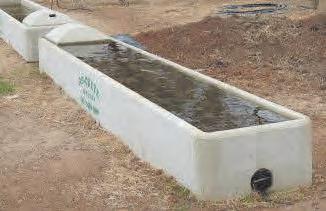















































SILAGE PRODUCTION in Australia has more than doubled since the early 1990s.
Silage provides an opportunity to store high-quality forage that can maintain high levels of animal production, increase enterprise flexibility and create new marketing opportunities.
The need for producers to increase productivity and reduce costs has been a driving force behind the increased use of silage.
On many farms silage-making is now a regular annual operation.
Drought and concerns about climate change are causing other producers to consider the advantages of silage for longer term storage.
Improvements in silage-making technology and the availability of efficient silage-handling machinery have encouraged the adoption of silage on many farms.
Technological advances have enabled farmers to more consistently and more easily produce high-quality silage to feed to their livestock. These include:
Advances in knowledge that have improved silage-making practises (for example, the importance of
rapid wilting and ensuring an airtight seal).
Improvements in silage-making technology (for example, plastics and inoculants).
Machinery developments to improve the efficiency of silage production (for example, mowers, mower conditioners, tedders and precision chop forage harvesters).
More storage options (chopped, baled, bulk or individual sealing) that provide producers with greater flexibility of their silage system.
Improved mechanisation of silage feedout systems which can significantly reduce labour requirements and wastage.
Availability of machinery that allows silage to be fed in mixed rations.
The reasons a farmer makes silage will vary between farms and include personal preferences. The main reasons include:
The need to improve pasture utilisation and increase productivity per hectare.
The valuable role for silage as a pasture management tool.
Reduced reliance on irrigation


water and the need to maximise production per megalitre used.
Capacity to cut earlier in the season and produce a higher quality product compared to hay production.
Ability to spread the harvesting period over a longer period than for hay.
Reduced losses of dry matter and quality during field and harvesting operations and reduced susceptibility to adverse weather compared to hay.
Market demand for consistency of supply and quality of animal product (for example, milk or meat).
Silage can be a high-quality supplement for ‘out-of-season’ production.
Ability to grow a variety of crops for silage production (for example, maize, sorghum or cereals). This diversity can increase farm productivity to levels higher than possible with pasture alone.
Suitability of silage for long-term storage of high quality feed for drought or flood reserves.
Potential to salvage high-quality forage from drought or frost-affected crops (for example, canola or winter cereals).
– From NSW DPI.





• Next generation, iron-based, all weather slug & snail bait with technology for maximum attractiveness, palatability and persistence
•Gentle on the environment, crops and non-target organisms
•Nil withholding period for grazing and harvest
•Certified input for organic production
FARMER AND contractor Richard Stecher admits grease, oil and coolants are seldom seen as the ‘star of the show’, but is adamant high-quality lubricants are integral to the success of his diversified agricultural enterprises.
Based on his property near Seymour, in Victoria, Richard is a first-generation farmer who manages 4000 hectares of winter cereal crops and runs a small herd of Angus breeders. He also owns and operates Stecher Ag — which delivers silage, hay and harvesting contracting services across the eastern states of Australia.
Since starting his business more than 20 years ago, Richard has grown his fleet of equipment to 15 John Deere tractors, two John Deere S-Series harvesters and two John Deere balers, with a combined 250,000 hours on the clock, through meticulous planning and maintenance regimes.
“I learned early on that if you want your tractors to pay for more tractors, that's not hard, but if you want your tractors to pay for more land, you need to really dot your i's and cross your t's,” Richard said.
Part of this process is ensuring optimal care of the Stecher Ag fleet which, like most farming entities, is always racing against the clock to beat the weather, prevent downtime and to take off crops when they’re at optimal quality.
“The value for money in John Deere lubricants is a no-brainer for me,” Richard said.
“Twenty years ago, when I bought my first John Deere tractor, the salesman had been a

Richard
well-regarded technician and spoke very highly of the lubricants, so I started using them and we’ve stuck with them ever since.
“We've done about 250,000 hours on John Deere equipment and we've never had a tractor split or a transmission failure.
“If you do the economics on the low failure rate of the product, it will stack up every time. Even the work utes and trucks get John Deere oil.”





The Stecher Ag fleet contains tractors of all ages and hours, so preventative maintenance is high on Richard’s agenda, ensuring the machines keep running, regardless of conditions.
“There are tractors in our fleet with 10,000 and 12,000 hours on them and they’re used day-in, day-out. You can hook a baler onto a tractor and drive it at 50km/h for two hours in 40-degree heat.

“So the fact that we've never had any major failures in transmissions is testament to the quality and longevity of the lubricants.”
Stecher Ag uses a range of John Deere products designed for heavy-duty applications, including Plus-50 II premium engine oil, Hy-Gard hydraulic/transmission oil, GL-5 gear oil, and Therma-Gard coolant, now marketed under the Cool-Gard brand.
Richard said he notices the difference the lubricants make in keeping the tractors cool in hot, dry and dusty conditions, and the extended working life of each machine makes it worth the cost.
“We might pay a few hundred dollars extra for a 205-litre drum of Hy-Gard, for example, but out of every drum of oil we get a couple of major services.
“If you calculate that over a 9000-hour lifespan, a tractor has only six major services. For the peace of mind, it’s worth it.”
With eight or 10 tractors doing more than 1000 hours a year, the services come around fast.
Richard said he uses the extended drain interval for oil changes at the 500-hour interval.
“We always take the engines out to 500 hours and when we drain it, the oil still seems quite viscous. We have very little or no oil burn, even out to those intervals.
“We say around here, the poor man pays twice. And I think if you cut corners, it'll bite you every time.”













DURING NATIONAL Farm Safety Week in July, Farmsafe Australia turned the spotlight on the critical importance of vehicle and machinery safety.
Farm vehicles and machinery are indispensable tools in modern agriculture, but their operation comes with inherent risks.
By adopting straightforward safety measures, farmers can create a safer working environment and enhance overall productivity.
Farmsafe Australia chair Felicity Richards says prioritising safety not only protects the lives of farm workers but also contributes to the overall efficiency and sustainability of agricultural operations.
Ensuring that everyone on the farm understands and follows these safety measures is crucial for maintaining a safe and productive working environment. Mrs Richards also emphasised the significance of building habits.
"In the daily busyness of life on the farm, we often overlook the simplest safety measures, or become complacent towards their importance in keeping our business running smoothly and efficiently,“ she said.
“Wearing seatbelts and
proper PPE in vehicles such as tractors and side by sides is a fundamental practice that requires a daily commitment.
"We often hear ourselves making excuses like, ‘it’s a flat paddock’ or ‘there’s too many gates to get in and out for’. But the reality is, when we carve out exceptions, we compromise safety. And ultimately, that puts lives and limbs at risk.“
Incidents involving farm machinery are a leading cause of injuries and fatalities, with 63 per cent of on-farm fatalities in 2023 being attributed to farm vehicles or mobile farm machinery.
Regular maintenance and inspections:
Conducting regular maintenance and thorough inspections of all vehicles and machinery ensures they are in optimal working condition.
This helps to identify and address potential issues before they become serious hazards.
Keeping a detailed maintenance log can aid in tracking the condition and service history of equipment.
Wearing seatbelts:
Seatbelts are a fundamental safety feature that can save lives in the event of a rollover or collision.
It is important to make wearing seatbelts a mandatory practice for all operators of tractors, machinery, and other farm vehicles such as utes and SSVs.
Providing proper inductions:
Comprehensive inductions for new, seasonal and returning workers are essential, covering the safe operation of all machinery, highlighting specific safety protocols and emergency procedures.
Refresher courses provided regularly are a great way to keep all staff updated on safe practices.
Creating a safe work environment:
Ensure that work areas are free of obstructions and hazards.
Clear communication with other workers about the movement and operation of machinery can prevent incidents.
Designating specific zones for machinery operation can further reduce risks.
Implementing safety protocols:
Establish and enforce safety protocols for all farm operations involving vehicles and machinery.
This includes guidelines for safe

driving, machinery operation, and the use of personal protective equipment (PPE).
Regularly reviewing and updating
•Feed any bale round & square, even the tightest bales with ease!
•Silent and reliable Chainless feeding system –for less maintenance and more reliability
•Massive 3,000 kg load rating – the strongest in the industry.

















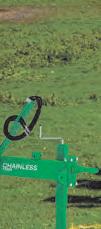



























































Eprinex®, proven on-farm, where it’s needed.





